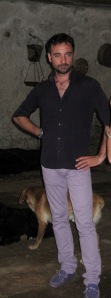
At the Wine Bank: a map of Italy’s most important varietals and their regions
The Piemonte region is an area in northwestern Italy, bordering France and Switzerland, with distinct seasons and mountainous terrain (literally: “foot of the mountain”). It is considered one of the greatest winemaking regions in Italy, renowned for its Barolo and Barbaresco red wines made from Nebbiolo grapes.
For the first day of the Piedmont stage, we stopped by the Banca del Vino (wine bank) housed inside the Agenzia di Pollenzo, which is also home to (you guessed it) the University of Gastronomic Sciences. Ah, familiar stomping grounds. Inspired by a vision from Carlo Petrini, the Banca del Vino is an effort to build a historical record of Italian wines, to select, stock and maintain the best of the Italian peninsula. Thus, the vault is part storage cellar, part museum, and holds a collection of wines from over 300 producers across Italy while providing tastings for visitors. They also offer themed workshops if you are interested in researching one region or varietal in particular. Outside of the vault, a large number of wines line the shelves and are available for sale. I was amused to see one labeled “Cornell,” although additional research suggests that the wine has nothing to do with my alma mater or Ezra Cornell’s descendants.
Continue reading Historical Wine Cellars in Piedmont






